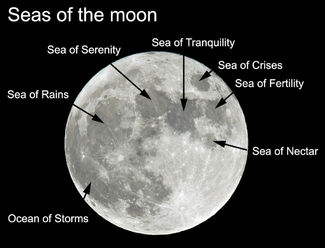Watery Moon
Last updated 9/17/2020 at 10am

The moon's lighter areas are mountainous or heavily cratered terrain, while the darker areas are roughly circular and cover much of the moon's face.
When the full moon rises in the east around sunset on Sept. 1, many stargazers around the globe will be watching.
To the eye, the full moon commands respect. Not only does its rising orb appear much larger than it actually is – an effect called the "moon illusion" – but its brilliance obliterates from view all but the brightest stars and planets. It's hard not to pay attention to the full moon!
But what most beginning sky watchers don't realize is that during the full moon is the worst time to view our nearest cosmic neighbor with a telescope because the sun's direct rays cast few shadows on its surface, giving it a rather flat appearance.
We can see, however, that the lunar surface is not uniformly bright, but rather, it shows a mottled appearance. We know the lighter areas as mountainous or heavily cratered terrain of higher elevation, and we call them the "lunar highlands." The darker areas are roughly circular and cover much of the moon's face; they are known as "mare" or "seas."
This watery terminology dates back to the earliest days of moon-gazing, long before astronomers realized that our natural satellite is a dry, barren world nearly devoid of water. It was a time when astronomers speculated that the smooth, dark nature of these regions might indicate the presence of huge oceans. Some even wondered if the moon might be a gigantic mirror that reflected the image of the Earth itself.
Today, we realize that these mare are huge plains of solidified magma that welled up from deep within the moon after violent impacts during its early evolution and flooded the lowest terrain.
Many of these features still carry the poetic names of antiquity such as the Sea of Nectar and Ocean of Storms. Perhaps most famous of these is the Sea of Tranquility, made famous by the Apollo XI mission that landed the first astronauts on the moon in July of 1969.
It lies on its westernmost side and appears near the top of the rising moon.
It is the interplay between the lighter lunar highlands and the darker mare that creates an illusion we call "the man in the moon." One lunar plain, the Sea of Serenity, marks one eye, while the Sea of Rains forms his other eye. A mountain range forms the bridge of his nose, and below, a collection of seas form his large, crooked smile.
At least, that's what I'm told; if you can make out a man's face from this maze of light and dark, you're doing much better than I. I can imagine someone sitting in a chair reading a book, a long-eared rabbit, even a frog, but I can't easily make out the "man in the moon."
Watch the full moon this week, and see which patterns you can find among its geological features. See if you can trace the profile of a ponytailed young lady wearing a diamond pendant. Why she looks to me like Wilma Flintstone is anyone's guess. I'll just leave it to all the amateur psychologists out there to figure out what this cosmic Rorschach test says about me!



